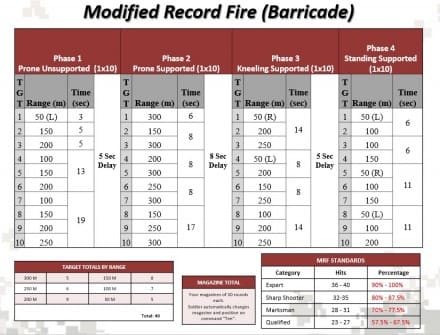The 82nd Airborne Division Master Gunner posted this information on their Facebook page regarding the US Army’s impending rifle qualification changes. In addition to a completely new course of fire called Table VI, standards have also changed. This is the most significant change to small arms marksmanship in decades. The Army has been building up to this, improving the rifles Soldiers use, introducing new ammunition and publishing new training manuals. Now, the challenge rests with NCOs like the Master Gunner who wrote this piece to prepare their Soldiers for this new standard. If you aren’t following the 82nd Master Gunner Facebook page, you need to.
For Training Tuesday, we will be looking at the changes in qualification standards that were briefed during the Maneuver Warfighter Conference last week, and what we can do to ready our Paratroopers for the change. The reference for this discussion is the 82nd Integrated Weapons Training Strategy LPD Slides.
Table VI (as record fire will now be known) has undergone some significant changes. The final product is slightly different from what you see here, but only in the exposure times. The basic structure remains the same. There are four tables: prone unsupported, prone supported, kneeling supported, and standing supported. Each table has one magazine of ten rounds, with up to four targets presenting at once.
Between each table, there is some time built in for the firers to transition from position and change magazines. If you doubt whether the time is enough, reference the live video we put up last week showing Paratroopers of the 1st Battalion, 508th Parachute Infantry Regiment conducting dry-fire of the table smoothly. However, that time does not begin until the target’s exposure time is complete. Firers have to be on the lookout for more targets and at further distances than they engaged before.
The prone supported has five exposures of the 300-meter target. Paratroopers have to engage them if they want to qualify expert. Paratroopers will have to engage at least 3 of the 200-meter targets to qualify.
Table VI is a non-alibi course of fire. Firers will get one attempt to qualify at marksman or higher. If they have a malfunction, they must perform immediate or remedial action and reduce the malfunction. As in combat, just because your weapon is out of operation does not mean threats will not stop presenting. If they do not achieve the standard of 23 out of 40 the first time around, regardless of what they score the second time, they are ‘qualified.’ That means no badge, no promotion points, and you can try again in four months. Moreover, the standard for Marksman has increased from 23 to 28.
If you do not practice this before coming to the range, you will fail. If our current qualification is analogous to doing the Army Physical Fitness Test, then the new qualification is the Ranger Physical Fitness Test. You can not do PT and fudge your way through the APFT and still pass… You cannot do the same for the RPFT and achieve a passing score.
Units will have to conduct dry-fire before coming to the range. In the Integrated Weapons Training Strategy, units have up to six weeks before the qualification date to pencil in one hour a week to conduct dry-fire training. This is an achievable standard.
Start by leading the Paratroopers through the drills as illustrated in the video we put up last week. Use the Master Gunner Cell Dry-fire calendars for Rifle as a quick reference, and start changing up the presentation of drills. The ‘fight up’ and ‘fight down’ drills start with standing, kneeling, squatting and prone positions. Have Paratroopers practice tactical and emergency magazine changes during all the positions, not just standing. Also, have them practice Immediate Action (‘Tap-Rack-Reassess’) and Remedial Action for time during all the positions.
Once that is starting to be easy, incorporate all the positions in Chapter 6 of the TC 3-22.9. Incorporate the use of loopholes, canted shooting, and time standards. Make them challenging, and leaders need to record that information as well. If you don’t keep track of it, you don’t know how well they’ve done and improved.
These are just a few ideas on how to incorporate dry-fire preparations for qualification into your calendar. Doing this will make your Paratroopers want to actually pick up their weapon, pick up a TC and learn something. And dare I say it, it is fun. If you make it an enjoyable activity, Paratroopers will want to do it more often. There is no excuse for not doing dry-fire. It is only a priority if we make it a priority. Squad and Team leaders need to do as they have always done, and get it done.

















































































































